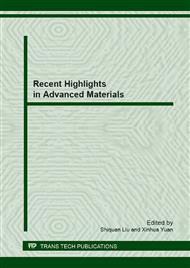[1]
Morikawa A., Kikuta K., Suda A., Shinjo H. Enhancement of oxygen storage capacity by reductive treatment of Al2O3 and CeO2-ZrO2 solid solution nanocomposite. Appl. Catal. B-Environ., 2009, 88, pp.542-549.
DOI: 10.1016/j.apcatb.2008.10.019
Google Scholar
[2]
Chen L.F., Hu J.C., Richards R.M. Catalytic properties of nanoscale iron-doped zirconia solid-solution aerogels. ChemPhysChem, 2008, 9, pp.1069-1078.
DOI: 10.1002/cphc.200800041
Google Scholar
[3]
Koparde V.N., Cummings P.T. Phase transformations during sintering of titania nanoparticles. ACS Nano, 2008, 2, pp.1620-1624.
DOI: 10.1021/nn800092m
Google Scholar
[4]
Carneiro J.T., Savenije T.J., ET AL. How phase composition influences optoelectronic and photocatalytic properties of TiO2. J. Phys. Chem. C, 2011, 115, pp.2211-2217.
DOI: 10.1021/jp110190a
Google Scholar
[5]
Carotta M.C., Gherardi S., Guidi V., ET AL. (Ti, Sn)O2 binary solid solutions for gas sensing: Spectroscopic, optical and transport properties. Sensor Actuat. B, 2008, 130, pp.38-45.
DOI: 10.1016/j.snb.2007.07.112
Google Scholar
[6]
Ahmed M. A., Yousef E.S., Abdel-Messih M. F. Preparation and characterization of nanocomposites in system as: SnO2-xTiO2 (where x=25, 50 and 75mol%). J. Sol-Gel Sci. Technol., 2011, 60, pp.58-65.
DOI: 10.1007/s10971-011-2550-4
Google Scholar
[7]
Shen Q.H., Yang H., Xu Q., Zhu Y., Hao R. In-situ preparation of TiO2/SnO2 nanocrystalline sol for photocatalysis. Mater. Lett., 2010, 64, pp.442-444.
DOI: 10.1016/j.matlet.2009.11.042
Google Scholar
[8]
Yu J.G., Liu S.W., Zhou M.H. Enhanced photocalytic activity of hollow anatase microspheres by Sn4+ incorporation. J. Phys. Chem. C, 2008, 112, p.2050-(2057).
DOI: 10.1021/jp0770007
Google Scholar
[9]
Hirano M., Dozono H., Kono T. Hydrothermal synthesis and properties of solid solutions and composite nanoparticles in the TiO2-SnO2 system. Mater. Res. Bull., 2011, 46, pp.1384-1390.
DOI: 10.1016/j.materresbull.2011.05.016
Google Scholar
[10]
Martínez A.I., Acosta D.R., Cedillo G. Effect of SnO2 on the photocatalytical properties of TiO2 films. Thin Solid Films, 2005, 490, pp.118-123.
DOI: 10.1016/j.tsf.2005.04.060
Google Scholar
[11]
Tu Y.F., Huang S.Y., Sang J.P., Zou X.W. Synthesis and photocatalytic properties of Sn-doped TiO2 nanotube arrays. J. Alloys Compd., 2009, 482, pp.382-387.
DOI: 10.1016/j.jallcom.2009.04.027
Google Scholar
[12]
Zeng W., Liu T. M., Wang Z. C., Tsukimoto S., Saito M., Ikuhara Y. Selective detection of formaldehyde gas using a Cd-doped TiO2-SnO2 sensor. Sensors, 2009, 9, pp.9029-9038.
DOI: 10.3390/s91109029
Google Scholar
[13]
Karunagaran B., Uthirakumar P., Chung S.J., Velumani S., Suh E. -K. TiO2 thin film gas sensor for monitoring ammonia. Mater. Charact., 2007, 58, pp.680-684.
DOI: 10.1016/j.matchar.2006.11.007
Google Scholar


